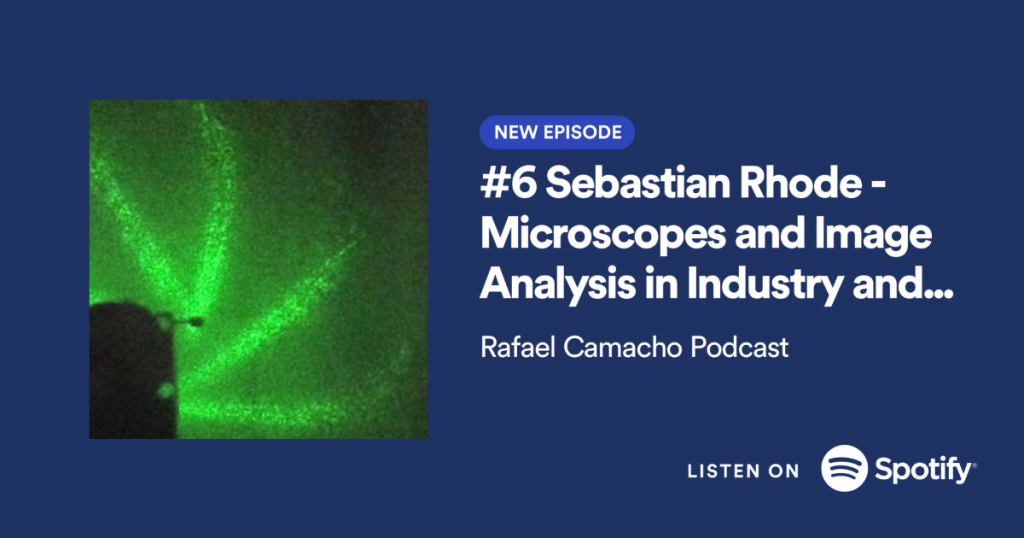Podcast about Bio-Image Analysis, Microscopy, and Science in General
Posted by Rafael Camacho, on 7 July 2021

Why a podcast?
At my home university, I was formally trained as a chemist. That meant I spent significant amounts of my time in front of the lab bench. I loved lab work, and an important part of the lab’s culture was the radio. There was no successful chemistry without good radio in the background.
My life at the chemistry bench did not last long. After some years, I found that I enjoyed building microscopes more than synthesising new molecules. However, my love for radio never disappeared, it only got redirected towards podcasts as the internet evolved. Moreover, podcast and hosting services improved to the point where having my own podcast was a real possibility. But would this make sense? I did not want to do it solo. I wanted people to come and talk to me about topics close to my heart: microscopes and image analysis.
The next step was obvious. I reached out to colleagues and friends, and I asked if they would be interested in participating. To my surprise, they not only said yes, but they were also excited about the idea. Critical here was Robert Haase. I had talked to him about the podcast idea on more than one occasion, and he was always very supportive. The inception idea came over a chat we had while organising an image analysis course. As usual, by the end of our meeting, the conversation (d)evolved to a light-hearted chat about image analysis in general. At some point, it was clear to me that if we would have recorded that session, then perhaps other people could find it interesting. I guess that the rest is now obvious as Robert became the first guest in my podcast. Again thanks Robert for the support and the critical role you played in this little project of mine.
The idea of the podcast:
The idea of the podcast is simple: I enjoy talking to people that love what they do, no matter the topic skilful people are inspirational. I will concentrate on the topics of microscopy and image analysis. However, I will step out of that line once in a while to explore other ideas and fields, particularly in science and technology.
Episodes related to Bio-Image analysis:
E01: Robert Haase – Bioimage analysis, smart microscopy, GPU acceleration, and open-software development
Robert Haase is a group leader and bio-image analyst at the DFG Cluster of Excellence “Physics of Life” TU Dresden. In this conversation, Robert and I go over many interesting topics, covering the typical suspects such as image analysis, software development, GPU acceleration, CLIJ, clEsperanto, as well as some other technical and not-so-technical avenues.

E05 – Anna Klemm: Bioimage analysis, facilities, and the Nordics
Anna Klemm is the Head of the BioImage Informatics Facility, at SciLifeLab, in Sweden. SciLifeLab is a research infrastructure that provides access to a broad range of technologies in biosciences. Facilities like Anna’s support scientists from academia, industry, and health care. While Anna and I are in many ways colleagues, connected via Bio-Image Analysis and SciLifeLab, we don’t share the workspace, and we usually don’t get the chance to just talk. It was great to have her on the podcast and talk about her transitions from being a researcher to facility staff, from Germany to Sweden, how did she get involved with NEUBIAS, women in science, etc.

E06 Sebastian Rhode – Microscopes and Image Analysis in Industry and Academia
Sebastian Rhode is a Senior Product Owner in Machine Learning and Image Analysis at ZEISS microscopy. If you are involved in bio-image analysis, NEUBIAS, or the image.sc forum, then you probably know Sebastian. He is extremely active in the community, not only showing what ZEISS can do in this arena but also interacting and helping the open-source community when we have questions regarding ZEISS’ image format or their products.
For me, this podcast was a unique opportunity to chat about the interaction between academia and industry, and between the open-source community and the commercial solutions. We also cover many other topics, such as football, the love of building microscopes, smart microscopy, teaching, trust, hardware vs software, academia vs small and large companies and, much more.

What has come out of the podcast:
One of the first consequences of the podcast has been my increased love for the image analysis community in life sciences. Every single person I have approached has been incredibly open and welcoming to the possibility of participating, no matter the affiliation, position, or reputation.
When I started the podcast I just wanted to experiment with a new way of communicating science, and to talk about the topics I found interesting. After some time, I started to receive small words of encouragement from people that liked the podcast. Moreover, the most important feedback has been from few young scientists that found value and inspiration in the conversations I had with my guests. If I manage to encourage a few people to move towards Bio-Image Analysis and Science, then I would have done a much more impactful thing than I would have ever anticipated.


 (1 votes, average: 1.00 out of 1)
(1 votes, average: 1.00 out of 1)
